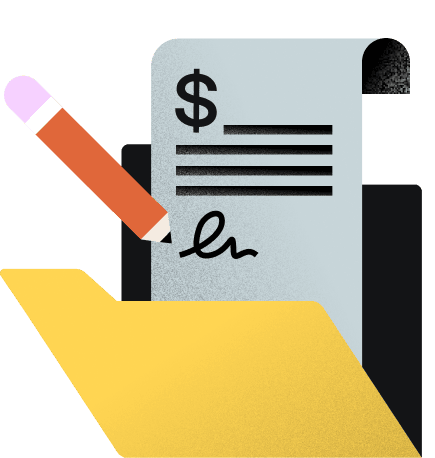Retainer agreements are a great way to improve your cash flow and build long-lasting client relationships. Learn when to use retainer agreements, how payments work, what to include in your agreements, and best practices for writing them.

A retainer agreement is a type of agreement in which a client pays a fee or a portion of the total fee up front for ongoing services. This payment arrangement can benefit the company or freelancer offering their services because it gives them income stability and enhances the trust between the independent service provider and the client.
Retainers can benefit clients as well. A clear contract outlining the services a business will deliver clarifies the client’s expectations. It ensures that both parties are on the same page and allows clients to budget accordingly. Clients can also rely on having a set amount of attention or access per month with coaches, consultants, or other independent service-based businesses.
Read on to learn about the types of retainer agreements, what to include in them, and how to use them to protect your business, improve your cash flow, and build your business relationships.
Jump to:
- What is a retainer agreement?
- Benefits of a retainer agreement
- When to use a retainer agreement
- Retainer agreement types
- How payments are structured in a retainer
- What to put in a retainer
- How to get contracts signed quickly and securely
Use these online contract templates to protect your business
HoneyBook offers free contract templates that you can customize to protect against cancellations and set client expectations.
Explore ContractsWhat is a retainer agreement?
A retainer contract, or retainer agreement, is a legal document stating the client pays for your services in advance. Details such as the duration of the agreement and the retainer fee can be found in the contract.
Retainer arrangements are popular for professional service companies such as law firms. Other types of service businesses can use them as well, such as consultants, photographers, and marketers.
Benefits of a retainer agreement
Improving cash flow
When clients retain your services, they pay up front for the time and attention you’ll provide them with. Typically, the funds they pay to retain your service will go toward the final bill after you deliver the service.
Having multiple clients on retainer can improve your cash flow and ensure you have enough funds up front to cover your own expenses. While a client is guaranteed a specified service, your company is guaranteed a specified income. This can add to the stability and predictability of your revenue.
Building relationships
A retainer arrangement is a business relationship between a client and the company. Having the client pay partially up front for your services confirms that the transaction is viable and that the client values your time enough to pay for something they know they will not have delivered right away.
Some clients could consider this a risk, but paying the retainer fee shows they trust you with their money and expect a good return on that investment.
Retainer agreements help small-business owners build professional relationships that last. Clients can gain great peace of mind, knowing they’re working with an expert who has guaranteed availability and understands their business.
Protecting your business
Like other contracts, a retainer agreement can protect your business. These agreements outline the duties and obligations of all parties involved, so there are clear expectations on both sides. Retainers and contracts can lessen the likelihood of a dispute.
With advance payments, the service provider can cover any expense that arises, even if the client cannot provide more funds or becomes unavailable. This way, you receive a guaranteed payment to the extent of the retainer fee.
When to use a retainer agreement
Your use of a retainer agreement may depend on what type of independent business you have, the types of services you provide, and the needs of your specific business. There are different kinds of retainer agreements that you can use for your business.
Retainer agreement types
The agreement that each party signs will cover the details of the arrangement, including the duration of the contract, the retainer fee, and the rights and responsibilities of each party. Those are the basic elements found in most contracts.
Here are the most common types of retainers; there can be a hybrid of different types as well.
Time-based retainers
With a time-based retainer agreement, a client can pay for a set amount of time during a period such as monthly or quarterly. This type of agreement can be in place when there is no known end date for a project, such as a designer being asked to assist with assets for a growing business.
Project-based retainers
A project-based retainer is determined using the scope of a project through project completion. It’s convenient to use this type of retainer when there’s a set deadline and end date with a well-defined project scope.
One example could be a content writer producing a certain amount of work for a monthly fee.
Pay-for-work
A common retainer arrangement is when a client pays up front for work that will be done in the future. This is a type of work-for-hire arrangement.
A pay-for-work agreement could be used by a marketing consultant offering services that a client can pay for either on a monthly basis or up front.
Pay-for-access
When a client pays to access a professional, such as a coach, it’s called a pay-for-access agreement. With this type of retainer arrangement, clients can make monthly payments. In return, the professional agrees to give the client attention when needed.
This type of retainer agreement could be used by a coach who agrees to be on call for a client for a monthly retainer fee. Whenever the client requires coaching, they can get in touch with their coach almost immediately, and the service will have already been paid for.
How payments are structured for a retainer
The payment structure for a retainer depends on the type of retainer agreement the client has with the company.
For work retainers, the retainer fees are held by the company to pay expenses as they arise during the project. Payments can either be recurring, such as a monthly payment, or a one-time payment that will go toward the final bill.
For access retainers, the client can make monthly payments that are a flat fee each month for access to the company or professional.
What to put in a retainer agreement
You can write your own retainer agreement from scratch or use HoneyBook’s free contract templates. Using a template is an easy way to get started with your contract. Templates give you the foundation for the contract and include all the essentials of a good contract. You can amend and append the template to suit your purposes.
Whichever way you write your agreement, seek legal counsel to ensure your terms and conditions are legally compliant in your state and that the agreement or contract offers the level of protection you need.
Elements of a typical retainer agreement
Agreements may differ across types of businesses, but for the unique purposes of your individual business, there are certain elements you’ll want to include in your client contracts.
Basic details
Every legal document needs to include basic details regarding each of the parties involved, such as individual names, company names, and contact information. When you use an online contract platform, the details can be autofilled for your convenience.
Scope of the service
Spell out exactly what you will be providing for the client. You may also want to indicate whatever may be out of the scope of the particular project, which you will not cover with your service. Being as detailed as possible can help you avoid conflicts and misunderstandings about what exactly you’ll be doing for your client and what you will not be able to do.
Duration of the service
For ongoing projects, the agreement does not have to include a termination date. Otherwise, set an end date for the agreement. Indicate whether the client can terminate the contract early and under what circumstances.
Retainer fee and expenses
Set the retainer fee and establish how often the client should make payments. This way, there are no surprises, and the client knows exactly how much they need to pay. Depending on the individual agreement, you may also include your hourly rate. Therefore, if you perform any additional tasks outside of the initial scope of the project, the client understands how you’ll bill them. The client should be aware that the retainer fee goes toward the final bill, but the final bill may increase during the time of the retainer agreement. There may be additional expenses that the client will be liable to pay as well.
Rights and obligations of parties
Include in the agreement the rights of termination by either party, dispute resolution, and the expectations of each party, which may include the method and frequency of communication.
RELATED POST
How to get contracts signed quickly and securely
One way to ensure your interests are protected while retaining your peace of mind is by using an online contract platform that facilitates quick and easy online signing for all parties involved. With HoneyBook’s online contracts, all of the essential information from each of the parties can be automatically filled into the contract or online invoice. You can even automate the propagation of a contract after service selection. This will decrease the back-and-forth and simplify your clientflow.
Use HoneyBook’s platform to make contract signing easier for both your business and your clients:
- Auto-fill dates, locations, names, and more
- Clients can sign online from any device
- Preview the contract from your client’s point of view to make sure the contract is perfect
- Signatures and initials are legally binding once the contract is signed
- Automatically send documents and emails after the client signs, freeing up your business from having to do these tasks manually
- Use the app for your convenience, available for iOS and Android devices
- Get notifications when clients sign documents.
HoneyBook has your back
HoneyBook’s clientflow management platform can help jump-start your relationships with clients and help you get to business on your own terms. Independent businesses of all kinds can use a whole suite of tools that help with clientflow, contracts, and secure signatures. Clients are invoiced, and payments are processed, including recurring fees for retainer agreements.
Get paid faster, have your contracts signed quicker and more securely, and track your payments on one platform.

Use HoneyBook’s ironclad contract templates to protect your business and clients.




